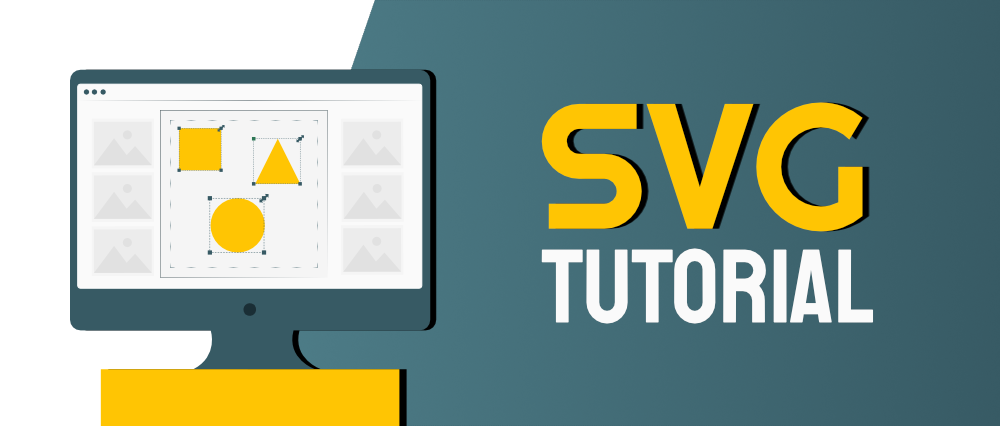SVG Tutorial
Last Updated :
16 Apr, 2024
SVG, short for Scalable Vector Graphics, is a powerful web standard that enables the creation of resolution-independent graphics. Unlike raster images (such as JPEG or PNG), SVG graphics maintain quality even when zoomed or resized. SVG defines vector-based graphics using XML format, making it an ideal choice for creating dynamic and visually stunning graphics on the web. SVG is supported by all major browsers.
In this SVG tutorial, we’ll learn all topics of SVG such as transformations, animations, and interactivity, mastering the art of creating dynamic and visually stunning graphics for the web.

What is SVG?
SVG is an acronym for Scalable Vector Graphics. It is used on the Web to create vector-based graphics. The graphics are defined in XML format, and each element and attribute in SVG files can be animated. SVG is recommended by W3C and can be integrated with other standards such as CSS, DOM, XSL, and JavaScript.
Why Learn SVG?
- Dynamic Graphics: SVG allows developers to create interactive and dynamic graphics, enhancing user interactivity. It is particularly useful for data visualizations, interactive maps, and other engaging web elements.
- Smaller File Size: SVG images have smaller file sizes compared to raster formats, resulting in faster website loading times.
- Browser Compatibility: SVG is compatible with most modern browsers, ensuring consistent rendering across different platforms.
- Integration with HTML & CSS: SVG seamlessly integrates with HTML and CSS, allowing developers to create complex and responsive design layouts.
- Versatility: SVG supports various types of graphics, including icons, logos, charts, and maps.
How SVG integrates with HTML
There are several ways to use SVG within HTML:
- Inline SVG: Embed SVG directly within HTML using the
<svg> element. - External SVG: Link to an external SVG file using the
<object> or <img> element. - SVG as CSS Background: Use SVG images as backgrounds with CSS.
- Inline SVG with
<use>: Reuse SVG elements within HTML using the <use> element. - JavaScript Manipulation: Dynamically create or modify SVG elements using JavaScript.
Example of using svg
In this example we demonstrates an inline SVG example, showcasing a red circle created using the <svg> element.
HTML
<!DOCTYPE html>
<html lang="en">
<head>
<meta charset="UTF-8" />
<meta
name="viewport"
content="width=device-width, initial-scale=1.0"
/>
<title>Inline SVG Example</title>
</head>
<body>
<h2> SVG Image Example</h2>
<svg width="100" height="100">
<circle
cx="50"
cy="50"
r="40"
fill="red"
/>
</svg>
</body>
</html>
Output:

SVG Example Output
SVG Tutorial
Basics
SVG Elements
SVG Property
SVG Attributes
Application of SVG
- Web Graphics: SVG is widely used for creating graphics on websites, including logos, icons, buttons, and illustrations.
- Data Visualization: SVG is valuable for rendering data visualizations such as charts, graphs, and maps on web pages.
- Responsive Design: SVG graphics can scale without losing quality, making them ideal for responsive web design across various devices.
- Animation: SVG supports animation techniques, enabling the creation of interactive and dynamic visual elements on web pages.
- Icon Systems: SVG is commonly employed in icon systems due to its scalability, flexibility, and ease of integration with CSS.
- Print Media: SVG graphics can be used in print media such as posters, brochures, and presentations, providing high-quality scalable images for print output.
SVG Advantages
Advantages of using SVG over other image formats (like JPEG and GIF) are:
- SVG images are versatile and can be easily created and edited with any text editor.
- They can be searched, indexed, scripted, and compressed, making them highly customizable.
- One of the greatest benefits of SVG images is that they are scalable and can be printed at any resolution without losing quality.
- Additionally, SVG graphics are zoomable, meaning that they can be viewed up close without losing sharpness.
- As an open standard, SVG offers a lot of flexibility for developers and designers.
- Finally, it’s worth noting that SVG files are pure XML, which makes them easy to work with and compatible with a wide range of software.
FAQ’s on HTML SVG
What is SVG in HTML?
SVG is a web standard for vector-based graphics in the form of XML format. It helps to create the graphics
which are scalable and resolution-independent.
Why use SVG?
SVG facilitates to create the scalable, resolution-independent graphics maintaining the quality across
various modern Browsers & different screen-width devices.
What are the pre-requisite knowledge required for learning SVG ?
For Learning the SVG Basics, the knowledge of HTML and CSS can be helpful to understand.
What are the benefits of using SVG over raster images?
SVG facilitates the scalability without loss of image quality, can have the smaller file sizes for simple
graphics, along with supporting the interactivity and animation, that helps to make the responsive
web design.
Can SVG be used for accessibility?
Yes, SVG can be used to the accessible by adding the text descriptions or labels for elements within
the graphic. For this, the content can be accessible for the users having the disabilities which uses
the screen readers or different assistive technologies.
Share your thoughts in the comments
Please Login to comment...